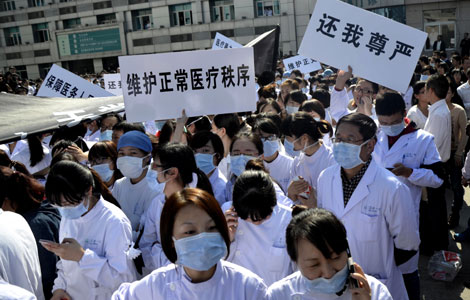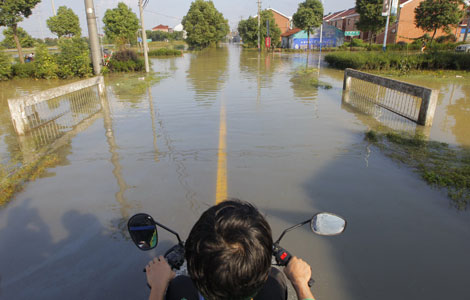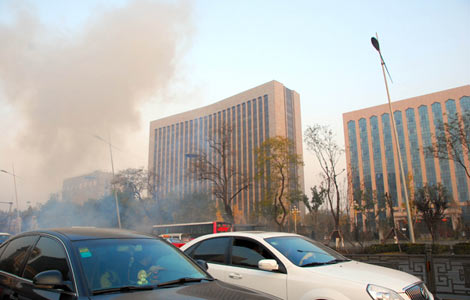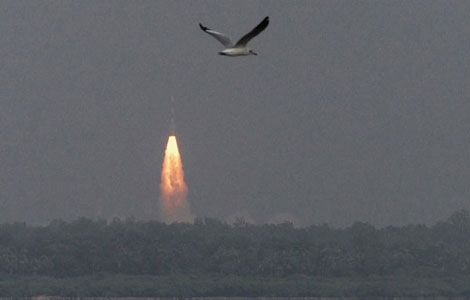Japan charts course for collective self-defense
Updated: 2013-11-07 00:52
By CAI HONG in Tokyo (China Daily)
|
||||||||
Over the next two or three weeks, Japanese Prime Minister Shinzo Abe's Cabinet is expected make a decision on whether to revise the government's stance on Japan's right to exercise collective self-defense, said a key security adviser to Abe on Wednesday.
In an interview with Reuters, Shinichi Kitaoka said Japan should change its constitution to allow its military to defend not only its ally the United States, but also other countries close to it.
If so, this would be a step further than expected.
During his recent overseas trips, Abe sold his doctrine of "active pacifism" and asserted Japan's right to collective self-defense in aid of US forces.
Japan's envisioned right of collective self-defense could cover Southeast Asian countries and sea lanes of vital interest to the country.
"If US vessels, Australian vessels or Indian vessels that are protecting this sea lane were attacked and this has a very big impact on Japan, then Japan has the right to cooperate with those countries and remove it (the threat)," Kitaoka was quoted by Reuters as saying.
Abe is stepping up efforts to change the government's traditional interpretation of Article 9 of its constitution.
The war-renouncing article holds that Japan cannot exercise the right to collective self-defense — the use of military power to repel attacks on a country that has close ties with Japan even if Japan is not directly attacked.
Successive heads of the Cabinet Legislation Bureau have said in parliament that collective self-defense goes again Article 9, a position shared by the previous government.
Abe has appointed Komatsu Ichiro, a supporter of the principle of collective self-defense, as the bureau's new director general.
On the one hand, the Abe administration is expected to expand the scope of Japanese military activities, removing the legal and other constraints.
On the other hand, Japan is beefing up its military capabilities.
As part of a large-scale military exercise, the Japan Self-Defense Forces fired surface-to-ship missiles to Miyako Island in Okinawa prefecture on Wednesday, according to Japanese news agency Jiji Press.
The large-scale exercise, which runs from Nov 1 to 18 and involves 34,000 personnel, is aimed at beefing up preparations to defend Japan's remote islands.
But by firing missiles at Miyako Island, Japan is also demonstrating its ability to block the Miyako Strait, which is part of international waters. China's Diaoyu Islands are not far away.
Japan's Defense Ministry said on Wednesday that the drill is not directed against any other country. Given the current tensions between China and Japan over territorial issues, the ministry's words ring hollow.
Japan's top-selling newspaper, Yomiuri Shimbun, reported that the National Defense Program Guidelines, which the Japanese government will approve by the end of 2013, will include plans to add two more Aegis vessels to the six already in service in the Maritime Self-Defense Forces.
The Aegis destroyers are a core part of Japan's ballistic missile defense system. Of the six vessels, four have the Standard Missile-3 system and are capable of intercepting ballistic missiles in space in cooperation with ground radar.
The two new Aegis-equipped vessels will be equipped with SM-3 Block IIA, the next-generation interceptor missiles, which is currently being developed jointly with the US. They are expected to be deployed within 10 years.
Japan's Lower House is expected to adopt a bill to create the Japanese version of the US National Security Council to serve as a foreign and security policy nerve center. The Japanese NSC will engage in policy coordination concerning diplomatic and security challenges among ministries and agencies to support the prime minister, who chairs the council.
"Judging from the Abe administration's political agenda, the NSC bill is only a first step in a radical shift in security policy," Asahi Shimbun's editorial said.
Most Viewed
Editor's Picks

|

|

|

|

|

|
Today's Top News
Lead author of Obamacare law blames govt for rollout
E China still top draw for foreigners
 De Blasio wins NYC's mayor race
De Blasio wins NYC's mayor race
 Minister proposes security fix
Minister proposes security fix
Japan charts course for collective self-defense
Shanghai a haven for investment
Plenum being chance for urbanization
Foreign executives continue to see opportunities in China
US Weekly

|

|















